
Vegetation Around Las Vegas

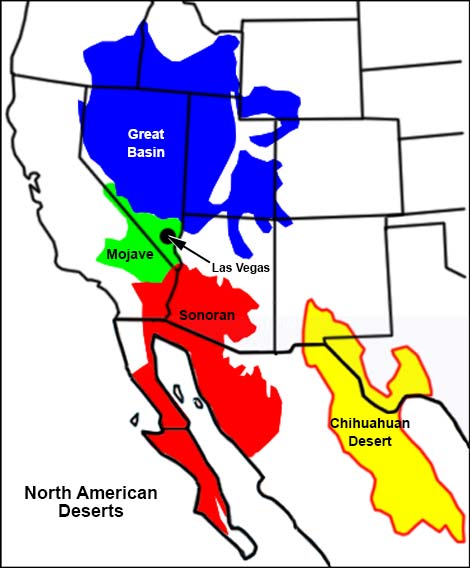 |
North American Deserts The North American deserts present a diverse assemblage of plants and animals that reflect regional differences in elevation, temperature, and rainfall. There are four major North American deserts (with many subdivisions), each with a distinctive character. From northwest to southeast, these four deserts are the Great Basin, Mojave, Sonoran, and Chihuahuan. Las Vegas is located in the northeastern portion of the Mojave Desert, a region influenced by the Sonoran Desert to the south and the Great Basin Desert to the north. The Chihuahuan desert, primarily a Mexican desert, lies far to the southeast and does not influence the Las Vegas region. The Great Basin, Mojave, and Sonoran deserts form a continuous region of arid lands with local differences that depend largely on elevation, temperature, and the timing and amount of precipitation. As such, the margins of these deserts overlap and form transition zones. The Chihuahuan Desert is separated from the other three by arid grasslands on the Continental Divide, so there is no transition zone. |
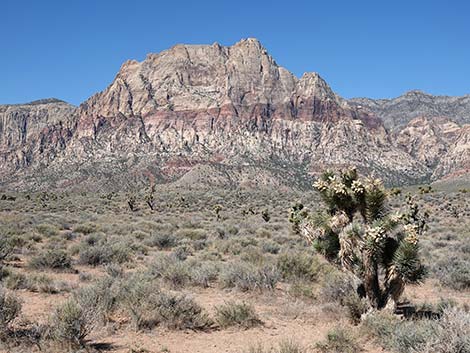 |
Mojave Desert The Mojave Desert is a hot, dry desert that receives small amounts of seasonally and annually unpredictable precipitation, but mostly during the winter (generally less than 6 inches of rain, many areas receiving less than 4 inches annually). This desert lies mostly in southern California, southern Nevada, and eastern Arizona. While summers are long and hot, short periods of freezing temperatures during winter limit the distribution of cold-intolerant plant species such as cactus, especially in northern areas. The Mojave Desert can be thought of as a vast expanse of creosote bush (Larrea tridentata) with scattered Joshua Trees (Yucca brevifolia) and yucca (Yucca spp.) at middle elevations. High mountain ranges support pine forests and alpine zones surrounded by low-elevation desert and isolated from other mountain ranges. In the Mojave, plants tend to grow in Life Zones or Biomes, an imprecise, but useful concept for organizing information about vegetation in the Mojave Desert. The life zones primarily depend on elevation, which in turn affects temperature (high elevations are cooler) and precipitation (high elevations are wetter). |
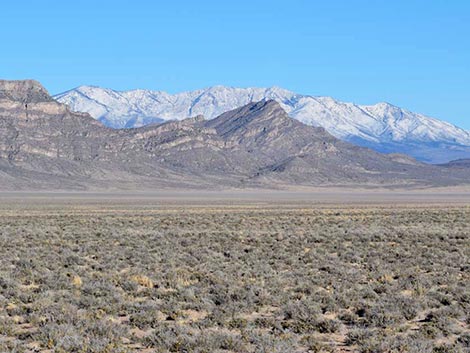 |
Great Basin Desert The Great Basin Desert is a cold, dry, high-elevation, northern desert that receives small amounts (4 to 11 inches) of predictable precipitation as snow during long winters. This desert lies mostly in central and northern Nevada. The Great Basin was named for the fact that little water escapes the region, instead flowing into lakes without outlets and into basins where the water dries to form alkali flats and dry lake beds. Because of this, much of the valley soils are alkaline or salty. The Great Basin actually is a series of basins separated by mountain ranges often exceeding 10,000 feet in elevation; most basins are over 4,000 feet in elevation. The Great Basin Desert can be thought of as a vast expanse of big sagebrush (Artemisia tridentata) and saltbush (Atriplex spp.), with pinyon-juniper woodlands at higher elevations and few cactus and other succulents. The high mountain ranges support pine forests and alpine zones. |
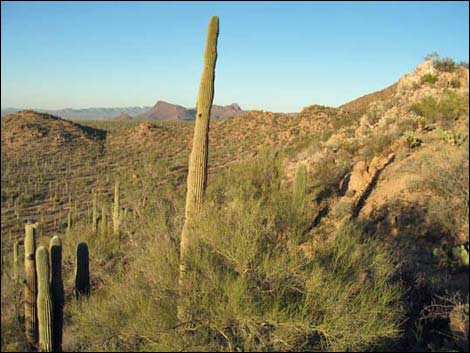 |
Sonoran Desert The Sonoran Desert is a warm, low-elevation (generally less than 2,000 feet) subtropical desert that receives relatively large amounts of predictable rain during two rainy seasons: the winter season and the summer monsoon season. This desert lies mostly in Arizona and Mexico. The vegetation is diverse: lowest elevations are dominated by creosote bush, while higher regions are dominated by large species of cactus (e.g., saguaro, Carnegia gigantea, and organ pipe cactus, Lemaireocerus thurberi) and paloverde trees (Parkinsonia), set in a diverse assemblage of thorny shrubs and cactus. High mountains support Madrean forest that extend north from Mexico, producing "islands in the sky" or "sky islands" of rich tropical biodiversity surrounded by low-elevation desert and isolated from other mountain tops. Most of this desert lies in Mexico. |
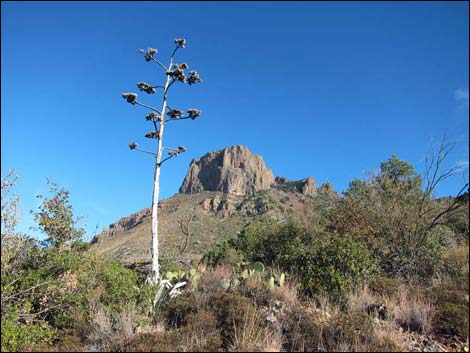 |
Chihuahuan Desert The Chihuahuan Desert is a hot, high-elevation desert that receives moderate amounts of predictable precipitation (mostly less than 10 inches) during the summer monsoon season. This desert lies east of continental divide, mostly in Mexico, but it extends into southeastern Arizona, southern New Mexico, and west Texas. Elevations generally are high, mostly between 3,500 and 5,000 feet, and as a result, temperatures fall below freezing during winter nights. Vegetation is characterized by grasses, small cacti, and frost-tolerant species such as woody lilies, particularly lechugilla (Agave lechugilla) and soaptree yucca (Yucca elata). Yuccas and agaves, growing with grasses and creosote bush, give this desert a characteristic appearance. Lechuguilla and tarbush are characteristic plants of the northern Chihuahuan Desert. |
All distances, elevations, and other facts are approximate.
![]() ; Last updated 220718
; Last updated 220718
| Vegetation Around Las Vegas | Glossary | Copyright, Conditions, Disclaimer | Home |